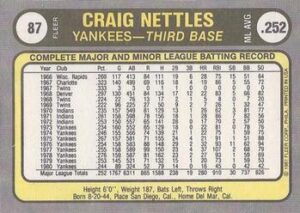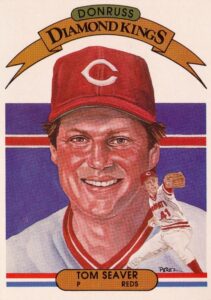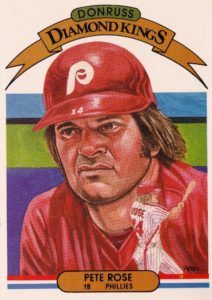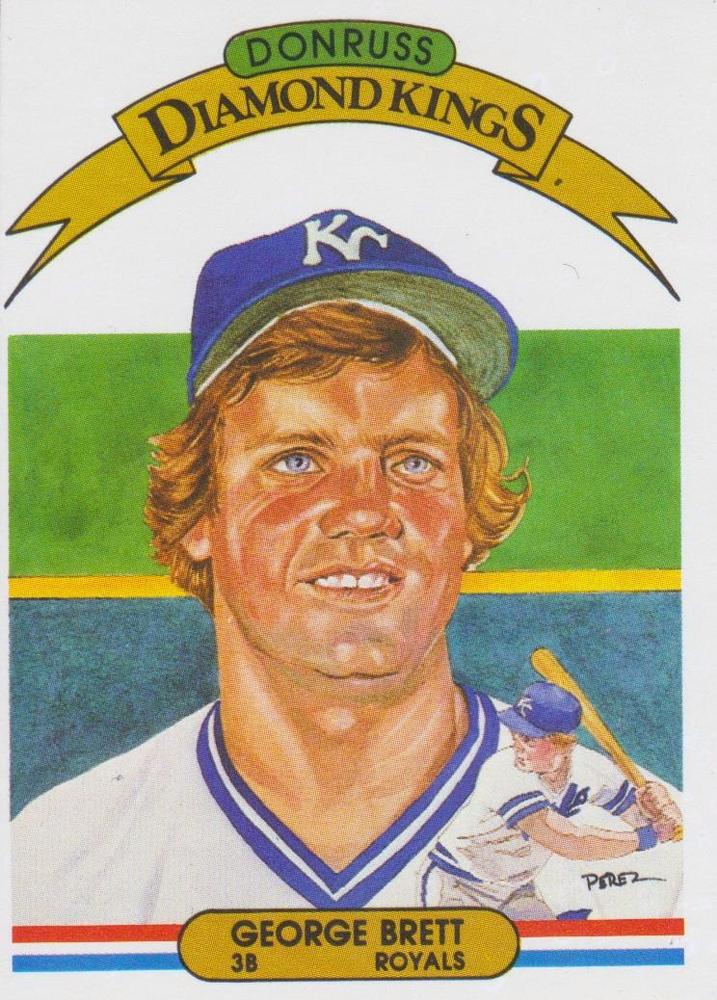Portions reprinted with permission from the University of Missouri Press
In writing my book, Suds Series, I had the opportunity to talk to the great baseball artist Dick Perez about his partnership with Donruss and how the Diamond Kings series of baseball cards came into being.
What follows is an excerpt from the book and an interview with Mr. Perez.
Baseball Card History
“We’re very pleased with the court’s decision,” said Fleer president Don Peck. “We’ve felt from day one that Topps and the players association were in violation of antitrust laws.”
The ruling handed down by US district judge Clarence C. Newcomer in Philadelphia on July 1, 1980, ended the twenty-five-year stranglehold the Topps Chewing Gum Company had on the baseball card market. The company had held exclusive rights to produce baseball cards featuring player photos since 1966 when Fleer sold its existing contracts to Topps. The contract came with a noncompetition agreement, and, once it expired, Fleer, the maker of Double Bubble Chewing Gum, decided it wanted back into the game and sued. Topps argued that the cards were simply a marketing tool to entice consumers to purchase their gum rather than that of a competitor, but Newcomer disagreed, saying that concept was “outdated.”
Kids didn’t buy Topps gum over another brand because they came with baseball cards. They bought baseball cards that came with gum, and Newcomer recognized that in his decision. “For decades [baseball cards] have been an important and distinctive part of many childhoods,” he wrote. “The permanence of those cardboard pictures is a market reality that the court must recognize. A baseball card consumer… knows if he has not yet found Dave Winfield, Keith Hernandez, Robin Yount, or Ron Guidry. Baseball cards are the only product on a typical candy rack to set forth baseball statistics. They are, in other words, an education in baseball.”

Newcomer’s ruling stated that Topps and the Major-league Baseball Players Association had to grant at least one other card manufacturer publishing rights by 1981, and both Fleer and Donruss, the former manufacturer of Little Leaguer Chewing Tobacco Bubble Gum, quickly signed contracts. But the two companies were under a severe time crunch, and it showed in their initial offerings in 1981. Both the Fleer and Donruss cards were riddled with errors. Player names were misspelled, statistics were incorrect, and many of the photos were blurry or of otherwise poor quality, including a few Donruss bought from a young photographer named Keith Olbermann.
Topps appealed Newcomers’ ruling in the summer of 1981 and won, but Fleer appealed, and the case was eventually put in front of the Supreme Court, which ruled in Topps’s favor. But the contract Topps signed with players had a loophole. The contracts restricted Major-League Baseball players from appearing on any other card brand packaged alone or with candy. They did not, however, restrict players from appearing on cards packaged with other items, so Fleer and Donruss simply stopped including gum with their baseball cards.
 For 1982 Fleer included stickers while Donruss included puzzle pieces that, when collected and assembled, featured a painting of Babe Ruth done by noted baseball artist Dick Perez. But the puzzle wasn’t Perez’s only contribution to Donruss. Beginning in 1982, Perez painted a portrait of one player per team in a subset called “Diamond Kings” that were included in packs of cards. Perez had been working with the Phillies since 1972 and had also formed a relationship with the Baseball Hall of Fame with his business partner Frank Steele.
For 1982 Fleer included stickers while Donruss included puzzle pieces that, when collected and assembled, featured a painting of Babe Ruth done by noted baseball artist Dick Perez. But the puzzle wasn’t Perez’s only contribution to Donruss. Beginning in 1982, Perez painted a portrait of one player per team in a subset called “Diamond Kings” that were included in packs of cards. Perez had been working with the Phillies since 1972 and had also formed a relationship with the Baseball Hall of Fame with his business partner Frank Steele.
“We were happy doing HOF stuff and it didn’t even enter our minds to do baseball cards,” said Perez. “The other thing was I was very heavily involved with the Phillies at the time. I was busy enough and I wasn’t looking for more stuff but it was intriguing and I thought, ‘If you do baseball cards, that’s national. That’s beyond the Hall of Fame. The Hall of Fame is really an institution that appeals to the older baseball fan and I don’t think they’re as popular as they should be. But the baseball card industry was all over the place. So Frank and I decided to take it on. They were watercolors so it didn’t take me too long to do them.”
“Donruss was a division of Nestle and they got a license, but they knew nothing about baseball cards,” said Perez. “They got [New York Daily News writer] Bill Madden to write the backs of the cards and Bill knew our work and suggested they call us because we might have design ideas. Frank and I started talking and we thought, ‘Let’s bring art back to baseball cards.’”
“It was a need to separate themselves from Fleer and Topps and those companies weren’t doing what I was doing,” said Perez. “It made a good impression on the card collectors.”
 The initial “Diamond Kings” set featured Pete Rose as card Number 1 but with only one player represented per team, the choices were not always easy, particularly when factoring in the time it took to produce each piece. “By the middle of the [1981] season, I had to get started painting to get them produced. Frank was looking at the stats, and we knew that we had to represent every team. There were times when there were… thin achievements, like John Mayberry for Toronto in 1981. It wasn’t the best year anybody had [.218 with ten homers], but he had the best year on that team. Whatever system Frank had, I don’t ever remember having to eliminate somebody and replace them with someone else. We may have done one or two but basically, they hung in there.”
The initial “Diamond Kings” set featured Pete Rose as card Number 1 but with only one player represented per team, the choices were not always easy, particularly when factoring in the time it took to produce each piece. “By the middle of the [1981] season, I had to get started painting to get them produced. Frank was looking at the stats, and we knew that we had to represent every team. There were times when there were… thin achievements, like John Mayberry for Toronto in 1981. It wasn’t the best year anybody had [.218 with ten homers], but he had the best year on that team. Whatever system Frank had, I don’t ever remember having to eliminate somebody and replace them with someone else. We may have done one or two but basically, they hung in there.”
“I didn’t hear anything from anybody at the time other than that Donruss noticed that it helped sales. But I never heard from buyers of the cards or collectors of the cards. Now I’m starting to get tons of mail from kids who grew up in that era and collected them and now they reach out to me and send me things to sign and stuff like that. ”
Going, Going, Gone
Amazingly enough, of all the pieces Perez created he didn’t keep a single one.
Every original painting is either in a personal collection or at the Hall of Fame. But the paintings were not done to hang on Perez’s wall. They were done to please baseball card collectors and there is a quote from French artist Edgar De Gas that resonates with Perez:
"Art is not what you see, but what you make others see"
Edgar DeGas
“When I do my work, I want the viewer to know that they’re looking at a painting and not a photograph,” he said. “Something they’ve never seen before. It may look familiar but they have never seen the way it’s been transformed.”
“That’s what I think DeGas meant. You don’t paint what everybody sees, you gotta paint what they haven’t seen and that’s what created the whole impressionist movement.”
Perez Documentary
Filmmaker Marq Evans is currently working on a long-overdue documentary about the life of Perez and his contributions to the game. The trailer is below and if you support the project there are some great perks!


